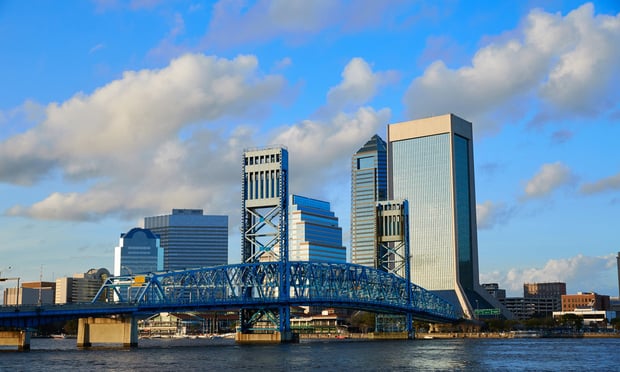CHICAGO—While many real estate investors are treading carefully when it comes to the banking industry, banks remain a solid option for credit driven investors, according to Chad Firsel, founder of the Chicago-based Quantum Real Estate Advisors.
With cap average cap rates falling between 5.6% to 6.9%, depending on term, location, credit, etc., investors can acquire high credit tenants at a relatively higher yield, he says. As for banks, they are making changes that are also attractive to investors. By expanding into urban markets and redesigning banks to be more transaction friendly, banks can put themselves in front of more consumers and provide quicker and easier transactions, Firsel tells GlobeSt.com.
For example, he notes that both Bank of America and JP Morgan Chase plan to expand their respective footprints. Bank of America, which currently has around 4,411 locations, plans to open 500 new branches in the coming years. JP Morgan Chase will have opened 90 new branches by the end of 2019.
Also, bank retail buildings as investments have proven to be a relatively liquid investment with three of the five major players having an average "months on market" of less than 6.5 months in 2019, Firsel says.
Following is Quantum's analysis on some of the major banks and what they mean for the net lease investor.
Bank of America
In 2018, Bank of America announced mobile deposits outpaced those made at branches for the first time. Technology adoptions have allowed the bank to shrink its physical branch footprint.
The bank has plans, however, to open more than 500 new branches in the coming years with an effort towards an optimal network of having branches in the top 30 urban markets that generates 88% of the US GDP.
- Avg months to sale: 7 months
- Avg CAP Rate 5.8%
- 2019 Avg $ Sale $3,000,000
BMO Harris Bank
Company has the greatest footprint in the Midwest, Arizona and Florida. As of June 2019, BMO was expanding its presence in North Texas with the launch of second commercial banking unit and asset based lending expansion in Boston and Atlanta.
- Avg months to sale: 14.5 months
- Avg CAP Rate 6.8%
- 2019 Avg $ Sale $1,900,000
JP Morgan Chase
The bank initiated a major branch expansion this year, opening up to 90 branches in new markets and hiring up to 700 employees by year end. Its market areas include Greater Washington D.C, Philadelphia, Boston and new retail branches in Charlotte, Raleigh, Greenville, Kansas City, Minneapolis, Nashville, Pittsburgh, Providence and St. Louis.
- Avg months to sale: 6.2 months
- Avg CAP Rate 5.60%
- 2019 Avg $ Sale $2,500,000
PNC Financial
PNC has been working to evolve its banking experience. New ATMs will enable banks to handle many banking transactions quicker and more efficiently. Bank branches are becoming smaller and more energy efficient, comprised of customer friendly lobby, ATMs, concierge stations, multiple meeting spaces and energy efficiency packages to reduce operating costs.
As of Aug 2019, PNC reportedly had plans to close 200 branches with ATMs staying in place and relying on mobile banking usage in those markets, creating a savings of $700 million.
- Avg months to sale: 7.2 months
- Avg CAP Rate 6.9%
- 2019 Avg $ Sale $1,800,000
TD Bank
TD Bank's Canadian branches have greater value than their US counterparts. US loans account for 23% of the bank's portfolio. This benefited the bank initially given the trajectory of rising interest rates, however when the Federal Reverse reduced rates, concerns over economic growth rose.
- Avg months to sale: 6.2 months
- Avg CAP Rate 6.1%
- 2019 Avg $ Sale $6,000,000
Wells Fargo
Over the past few years, Wells Fargo has been shrinking its physical footprint. With 200 branches closed in 2017, the bank had plans to close an additional 800 locations by 2020. This will leave Wells Fargo with about 5,000 branches. The strategy is a result of consumer preference for online and mobile banking. Wells Fargo also has had mounting legal litigation expenses.
The bank plans to have saved $4 billion with branch closures by end of 2019.
- Avg months to sale: 6.4 months
- Avg CAP Rate 6.50%
- 2019 Avg $ Sale $2,500,000
Want to continue reading?
Become a Free ALM Digital Reader.
Once you are an ALM Digital Member, you’ll receive:
- Breaking commercial real estate news and analysis, on-site and via our newsletters and custom alerts
- Educational webcasts, white papers, and ebooks from industry thought leaders
- Critical coverage of the property casualty insurance and financial advisory markets on our other ALM sites, PropertyCasualty360 and ThinkAdvisor
Already have an account? Sign In Now
*May exclude premium content© 2024 ALM Global, LLC, All Rights Reserved. Request academic re-use from www.copyright.com. All other uses, submit a request to [email protected]. For more information visit Asset & Logo Licensing.









